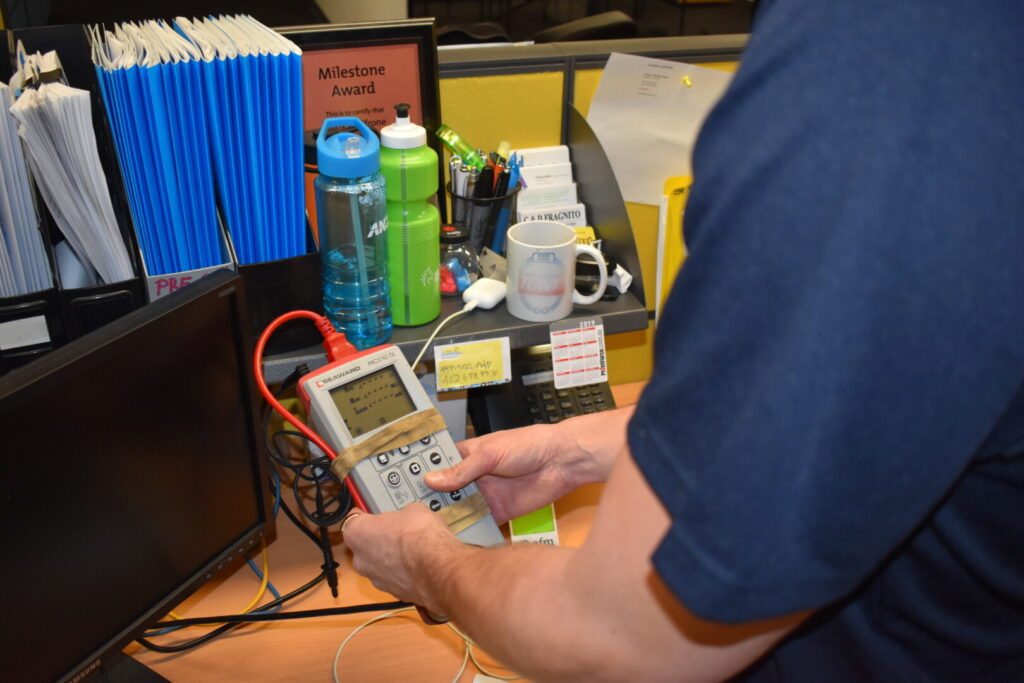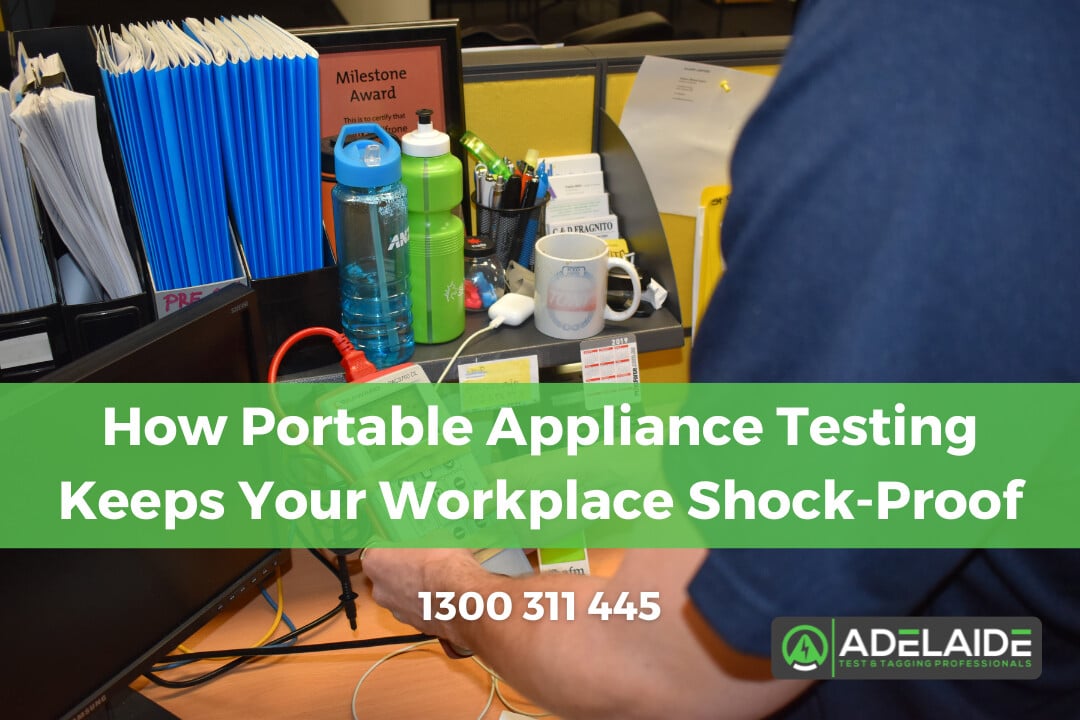Workplace safety is about more than just rules on paper or safety signage; it’s a commitment to protecting every person who steps through your doors. One of the biggest risks that often goes unnoticed is faulty or damaged electrical equipment. From computers and kettles in the office to power tools on a construction site, electrical appliances can pose a serious hazard if not properly maintained. This is where Portable Appliance Testing (PAT) comes into play.
Portable Appliance Testing is a proactive safety check designed to identify potentially dangerous electrical faults before they lead to electric shocks, fires, or costly downtime. By regularly testing your appliances, you create a safer working environment, comply with Australian safety standards, and protect your workforce from unnecessary harm. In this blog, we’ll take a closer look at why PAT testing is essential to keeping your workplace hazard-proof, how it works, and why you should never overlook this critical safety step.
What Is Portable Appliance Testing?
At its core, Portable Appliance Testing (PAT) involves a thorough inspection and electrical tests of portable electrical appliances that are regularly used in workplaces. This testing process checks the safety of these devices to ensure they are fit for use and do not present a risk of electric shock or fire.
In Australia, PAT testing is governed by the AS/NZS 3760 standard, which provides detailed guidance on how to carry out inspections and tests on in-service electrical equipment. The aim is to prevent accidents by identifying issues such as worn cables, broken plugs, or compromised internal components that could cause dangerous electrical faults. Essentially, PAT testing is about catching problems early before they escalate into serious incidents.

Why Is PAT Testing Important?
1. Preventing Electric Shocks and Fires
One of the primary reasons to undertake PAT testing is to prevent electric shocks and fires in the workplace. Electrical faults often develop slowly and are not always visible to the untrained eye. A cable might be frayed beneath its insulation, or a plug’s wiring may have loosened over time, creating a risk of short circuits.
Regular PAT testing detects these hidden issues, significantly reducing the chances of an electric shock to employees or visitors. Moreover, faulty appliances can easily ignite fires, especially when overheating or sparking occurs. By catching these hazards early, PAT testing plays a vital role in protecting lives and property.
2. Legal Compliance and Insurance
In Australia, workplace safety is taken very seriously under the Work Health and Safety (WHS) laws. Employers have a clear legal obligation to ensure the health and safety of their staff and visitors, which includes maintaining electrical safety standards. Failure to conduct routine PAT testing can lead to hefty penalties and potential legal action if an incident occurs.
Additionally, many insurance policies require evidence of regular safety checks, including PAT testing. If you neglect these checks and a workplace electrical accident occurs, your insurance claim could be denied, leading to significant financial losses. Regular PAT testing ensures you meet your legal duties and keeps your insurance coverage intact.
3. Protecting Your Reputation
Your reputation as an employer is invaluable. Incidents involving electrical accidents can severely damage your brand’s credibility and trustworthiness. Demonstrating your commitment to safety by scheduling regular PAT testing not only helps prevent accidents but also shows your employees, clients, and stakeholders that you value their wellbeing.
This proactive approach can improve staff morale and reduce absenteeism, as workers feel safer and more secure in their environment. In the competitive Australian market, being known for workplace safety is a strong advantage.
What Types of Equipment Need Testing?
Almost any electrical device that plugs into a power outlet is subject to Portable Appliance Testing. This includes both personal and communal equipment found in workplaces of all sizes and industries. Examples include:
- Computers and monitors used daily in offices
- Printers, scanners, and fax machines critical for business operations
- Kitchen appliances such as microwaves, kettles, and refrigerators
- Power tools and machinery used in construction and workshops
- Extension leads and power boards that distribute electricity to multiple devices
It’s important to note the difference between Class I and Class II appliances. Class I devices rely on earthing to prevent electric shock, while Class II appliances have double insulation for extra safety. Both types require testing, but the method and frequency can vary based on risk assessments and their environment of use.
How Often Should You Perform PAT Testing?
There is no one-size-fits-all answer for how often PAT testing should be done, as it largely depends on the type of equipment and the conditions in which it’s used. However, general industry guidelines can help you establish a schedule that keeps your workplace safe and compliant.
| Environment | Equipment Type | Recommended Interval |
| Construction Sites | Power tools, extension leads | Every 3 months |
| Offices | Computers, printers | Every 12 months |
| Workshops | Handheld equipment | Every 6 months |
High-risk environments, such as construction or manufacturing sites, require more frequent testing due to increased wear and exposure to harsh conditions. Low-risk environments, like office spaces, can often extend the intervals between tests, but should never neglect annual inspections.
Adopting a clear testing timetable ensures that all electrical appliances remain in safe working order throughout their lifespan.
What Happens During a PAT Test?
When you hire a professional to conduct Portable Appliance Testing, you can expect a comprehensive and systematic process:
- Visual Inspection: The technician starts by visually examining each appliance, looking for obvious signs of damage such as cracks, frayed cords, burn marks, or loose components.
- Electrical Testing: Using specialised PAT testing equipment, the technician measures insulation resistance, earth continuity, and polarity. These tests ensure the appliance’s internal wiring is intact and the device is properly grounded.
- Tagging: Once an appliance passes testing, it is tagged with a label that includes the test date, the next due date for testing, and the test result. This tag serves as proof of compliance and helps keep track of retesting schedules.
- Record Keeping: Detailed records of all tested appliances are maintained. These logs are essential for compliance audits and can help you quickly identify which equipment is due for re-testing or replacement.
Only qualified and experienced professionals should conduct PAT testing, as proper equipment handling and understanding of Australian safety standards are crucial to accurate and reliable results.
Benefits of Hiring a Professional PAT Testing Service
While it might be tempting to assign PAT testing to a staff member or try a DIY approach, the benefits of hiring a professional service far outweigh the cost savings of doing it yourself:
- Accurate Testing: Professionals use calibrated, industry-standard testing equipment and know how to interpret results correctly.
- Compliance Assurance: They ensure testing procedures meet the stringent requirements of AS/NZS 3760, avoiding any compliance pitfalls.
- Liability Reduction: Should an incident occur, professional testing records protect your business from legal claims.
- Time and Cost Efficiency: Outsourcing frees up your staff to focus on core business tasks while giving you peace of mind about safety.
- Expert Advice: Professionals can recommend repairs or replacements for faulty equipment, helping you maintain a fully safe workplace.
If your business is located in Adelaide or the surrounding areas, partnering with a trusted local provider such as Adelaide Test and Tagging means expert service tailored to your needs, delivered with local knowledge and prompt response times.
Tips to Keep Your Workplace Shock-Proof
Taking additional steps alongside regular PAT testing can dramatically improve electrical safety:
Use Only Tested and Tagged Equipment
Never allow untested or untagged appliances in the workplace. Encourage employees to report damaged equipment immediately and avoid using any device with missing or expired test tags.
Provide Safety Training
Educate your team on electrical safety awareness. Knowing how to recognise hazards and respond to faults can prevent many accidents.
Maintain a Regular Testing Schedule
Keep an organised calendar or digital system to remind you when each appliance’s retest is due. Proactive scheduling avoids missed deadlines and keeps your records up to date.
Replace or Repair Damaged Items Promptly
Don’t delay action on appliances that fail testing or show wear and tear. Prompt repairs or replacements eliminate ongoing risks.
Final Thoughts: PAT Testing Is a Smart Business Move
Ensuring your workplace is shock-proof through regular Portable Appliance Testing is not just a regulatory box to tick. It’s a fundamental part of creating a safe, productive, and legally compliant business environment. By identifying electrical hazards early, you safeguard your employees’ health, protect your assets, and uphold your organisation’s reputation.
If you’re searching for reliable PAT testing services in Adelaide, don’t hesitate to contact Adelaide Test and Tagging. Their professional, friendly team will help you implement a comprehensive testing program suited to your business needs.
Take the first step today because when it comes to workplace safety, prevention is always better than cure.


